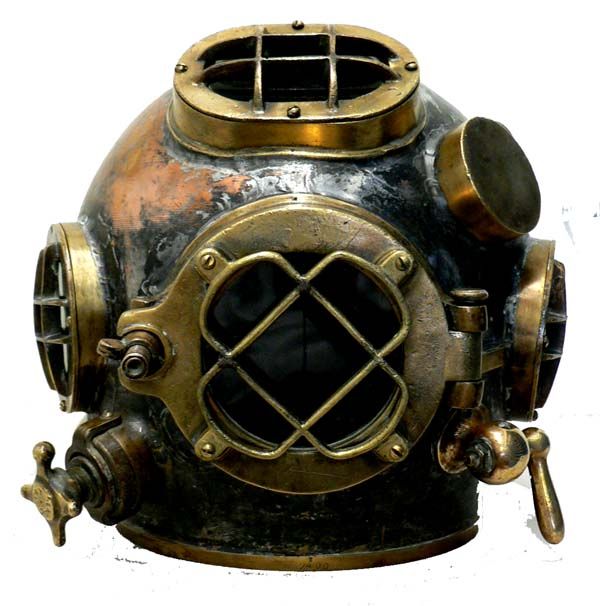
1919 MORSE NAVY MK V DIVING BONNET!

|
|
BRIEF HISTORY of NAVY MK V DEEP SEA DIVING DRESS:
By 1905, the Bureau of Construction and Repair had designed the MK V Diving Helmet
which seemed to address many of the problems encountered in diving. This deep-sea outfit was designed for extensive, rugged
diving work and provided the diver maximum physical protection and some maneuverability.The 1905 MK V Diving Helmet had an elbow inlet with a safety valve that allowed
air to enter the helmet, but not to escape back up the umbilical if the air supply were interrupted. Air was expelled from
the helmet through an exhaust valve on the right side, below the port. The exhaust valve was vented toward the rear of the
helmet to prevent escaping bubbles from interfering with the diver’s field of vision.By 1916, several improvements had been made to the helmet, including a rudimentary
communications system via a telephone cable and a regulating valve operated by an interior push button. The regulating valve
allowed some control of the atmospheric pressure. A supplementary relief valve, known as the spitcock, was added to the left
side of the helmet. A safety catch was also incorporated to keep the helmet attached to the breast plate. The exhaust valve
and the communications system were improved by 1927, and the weight of the helmet was decreased to be more comfortable for
the diver.After 1927, the MK V changed very little. It remained basically the same helmet
used in salvage operations of the USS S-51 and USS S-4 in the mid-1920s. With its associated deep-sea dress and umbilical,
the MK V was used for all submarine rescue and salvage work undertaken in peacetime and practically all salvage work undertaken
during World War II. The MK V Diving Helmet was the standard U.S. Navy diving equipment until succeeded by the MK 12 Surface-Supplied
DivingIn February 1980 the MK 12 was replaced by the MK 21 in December 1993.